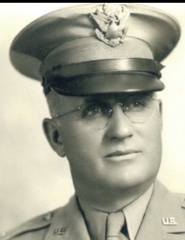IOWAN HELPS MILES FIND WAY
IDPA Writer Travels Road Under Fire
By FRANK MILES (Iowa Daily Press War Correspondent)
With the 5th Army in Italy—(IDPA)—My jeep driver and I were lost, looking for a division headquarters in North Italy.
Around a clump of trees on a bend in the mountain road we came upon a group of halted American infantrymen, eating K rations.
“Any one from Iowa here?” I inquired of 2 soldiers apart from the others, feeling that one from my own state might be more kindly disposed toward a scribe in distress.
“Don’t think any of this gang is from there,” was the reply in a pleasant drawl. “Most of us come from the south.”
Spotting the Major, who was in command, I told him my troubles. He was more than considerate and sympathetic, then firm.
“The Jerries are shelling that road you just came over with small arms and mortars,” he informed. “You should not be here, but I’ll tell you how to get back over a safer route.”
“Thank you, sir,” I said warmly. “What is your name and where are you from?”
He was Major Richard Oshlo, 23, Council Bluffs, who soon after graduation from Thomas Jefferson high school there went with an Iowa National Guard outfit for training at Camp Ripley in August of 1940 and answered call to active duty early in 1941. He had been overseas since April of this year and had seen a lot of action.
The Major has a brother, 2nd Lt. Robert Oshlo of the 168th Infantry, wsho was captured at Kaserine Pass in Africa and whom he believed is a prisoner in Germany, and another brother, Sgt. William Oshlo with a railroad battalion in England.
I promised to be more careful in the future, but the picture changes so swiftly in a battle area that it is difficult for anyone to give directions accurately and for anyone to fully understand those he gets.
During the day I saw soldiers digging foxholes in rocky, brush covered soil, soldiers camped on beds of stone at the edge of a stream in a ravine and foot soldiers marching up to positions where they would engage in deadly clashes with the enemy.
Frequent rains and cold weather make the job of beating the Germans all the harder and more hazardous but it is being done by the brave men of the 5th Army.
Capt. Lloyd M. Reiser, Sioux City, recently selected a site for his artillery headquarters in the midst of a $400,000 art treasure cache in North Italy.
The stone villa he chose was well enfiladed with enemy fire. He noticed some framed, life-sized sketches in the cellar but since he had often seen painting and sculptures in houses he had entered, he thought nothing of it.
A day or two later an AG official arrived to look for a certain collection, which had been placed in the building during the drive on Florence. He identified the large drawings as the work of several 16th century fresco painters, among them Tintoretto, Soroccio, Bronzine and Andrea del Sarto. He estimated their value at 40,000,000 lire.
Captain Reiser has a wife and 3 children in Sioux City.
Cpl. Albert J. Quigley, Davenport, a gunner, helped break a powerful German attack in Italy recently by placing 155-,illimeter howitzer shells within 100 yards of American infantrymen without dropping a single round short.
As gunner, Cpl. Quigley sets the sights to conform with the fire order and rapidly adjusts the gun barrel until the leveling bubbles are perfectly centered, indicating the barrel adjustment conforms to the setting. This calls for great precision and care, but the Iowan has to do the job in a few seconds.
He also is acting chief of section in which he gives commands to fire when the gun is operated singly and serves as minesweeping expert for his gun crew. His officers and comrades call him a splendid soldier.
Source: The Mason City Globe-Gazette, Saturday, October 28, 1944
![]()

